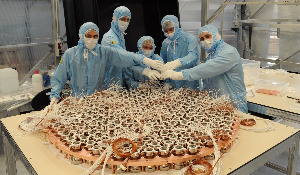Research Topics
It combines research, research training and education of young researchers in four fields:
- Experimental Particle Physics (Experimental Collider Physics, Flavour Physics, Dark Matter)
- Experimental Astroparticle Physics (Cosmic Rays, High-energy Neutrino Astronomy, Dark Matter, Neutrino Physics)
- Theoretical Particle and Astroparticle Physics (Dark Matter, Quantum Field Theory, Theoretical Collider Physics, Flavour Physics, Neutrino Physics)
- Technology Development (Computational Physics, Technology Development, Accelerator Research at KARA, Sensor Technologies and Detector Systems, Software Defined DAQ)
The research topics in these four fields are given below. In each of the topics as well as interdisciplinary PhD theses are possible.
Cosmic Rays
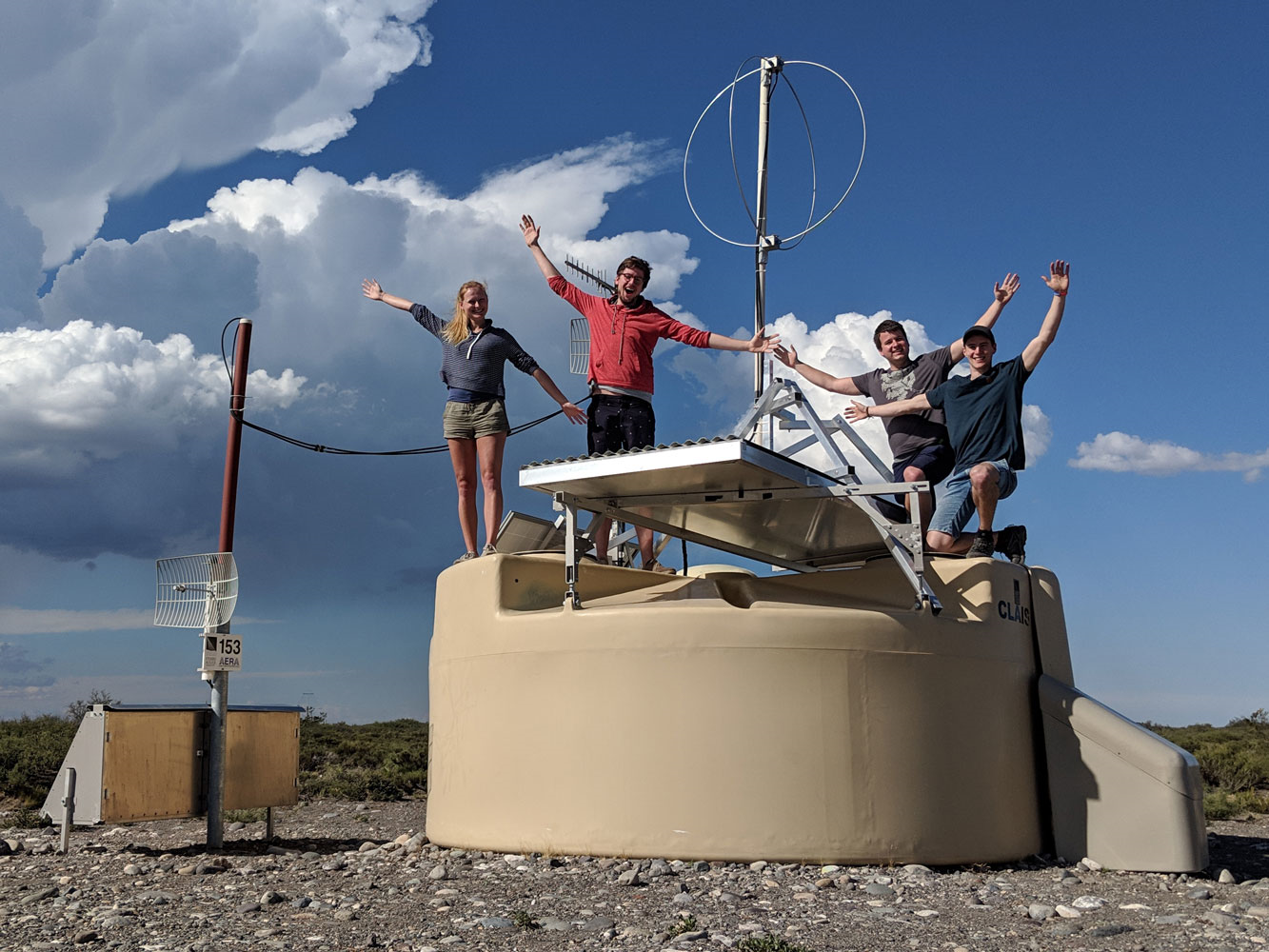
The Pierre Auger Observatory covers an area of 3000 square kilometres in the Argentine Pampa with more than 1600 autonomous surface detectors: In highly pure water, energetic particles produce light flashes. Scintillation detectors and radio antennas complete this array. In addition, four stations with 27 telescopes at the edge of the detector field observe the light tracks of cosmic particle showers. Underground muon detectors, an array of radio antenna stations as well as prototype detectors for a next generation cosmic-ray detector (GCOS) complete the experimental set-up.
Other activities in this research field concern cosmic ray measurements with IceCube and the analysis of the data of KCDC, the data center of the former cosmic-ray experiment KASCADE-Grande on KIT’s northern campus.
KIT is also the home of the air shower simulation package CORSIKA, which is undergoing continuous development.
KSETA PIs working in this field are Ralph Engel, Andreas Haungs, Tim Huege, Bianca Keilhauer, Matthias Kleifges, Frank Schröder and Markus Roth.
High-energy Neutrino Astronomy

IceCube is a neutrino observatory at the South Pole consisting of optical modules within a cubic kilometre of Antarctic ice. Neutrinos are elusive particles and important cosmic messengers that point to extreme astrophysical sources and provide insights into the processes that lead to the creation of particles with the highest energy. The surface part of IceCube, IceTop and the Surface Array Enhancement, enables the investigation of cosmic ray air showers, and serves as a veto for astrophysical events. Our group at KIT is working on both the analysis of IceCube data and the construction of the next generation of the IceCube experiment, IceCube-Gen2. As part of multimessenger astrophysics, we are also involved in the Einstein Telescope and are investigating correlations between neutrinos and gravitational wave events.
KSETA PIs working in this field are Andreas Haungs, Ralph Engel, Tim Huege and Frank Schröder.
Dark Matter
We are conducting experimental as well as theoretical research towards the identification of dark matter (DM). In the experimental (direct) search for DM we are member of the XENON and XLZD collaborations. While the XENONnT experiment is taking data since 2020 and has recently undergone a significant upgrade, XLZD is in its design phase. The Dark Matter Group at KIT has contributed significantly to the XENONnT upgrade and is actively involved in the data taking and analysis. Within XLZD, we are developing new techniques of large scale electrodes and operate a dual-phase Xe TPC for research and development (R&D). To complement the DM search towards light DM, the new ''Direct search Experiment for Light dark matter'', DELight, will be using superfluid helium as active target, instrumented with magnetic micro-calorimeters. Here, we concentrate on sensitivity studies, calibration schemes, as well as the development of large-area cryogenic microcalorimeters.
KSETA PIs working in this field are Yanina Biondi (experiment), Klaus Eitel (experiment), Torben Ferber (experiment), Felix Kahlhöfer (theory), Sebastian Kempf (technology), Markus Klute (experiment), Thomas Schwetz-Mangold (theory), Kathrin Valerius (experiment) and Robert Ziegler (theory).
Quantum Field Theory

The fundamental building-blocks of matter, elementary particles, are described by the so-called Standard Model which provides information about their properties and the forces acting between them.
The research groups at KIT which work in theoretical particle physics perform complex perturbative calculations and non-perturbative considerations within the Standard Model or of hypothetical theories of New Physics in order to test the quantum nature of the theory and to extract fundamental constants of nature.
KSETA PIs working in this field are Anke Biekötter, Monika Blanke, Gudrun Heinrich, Kirill Melnikov, Margarete Mühlleitner, Ulrich Nierste, Matthias Steinhauser and Robert Ziegler.
Experimental Collider Physics
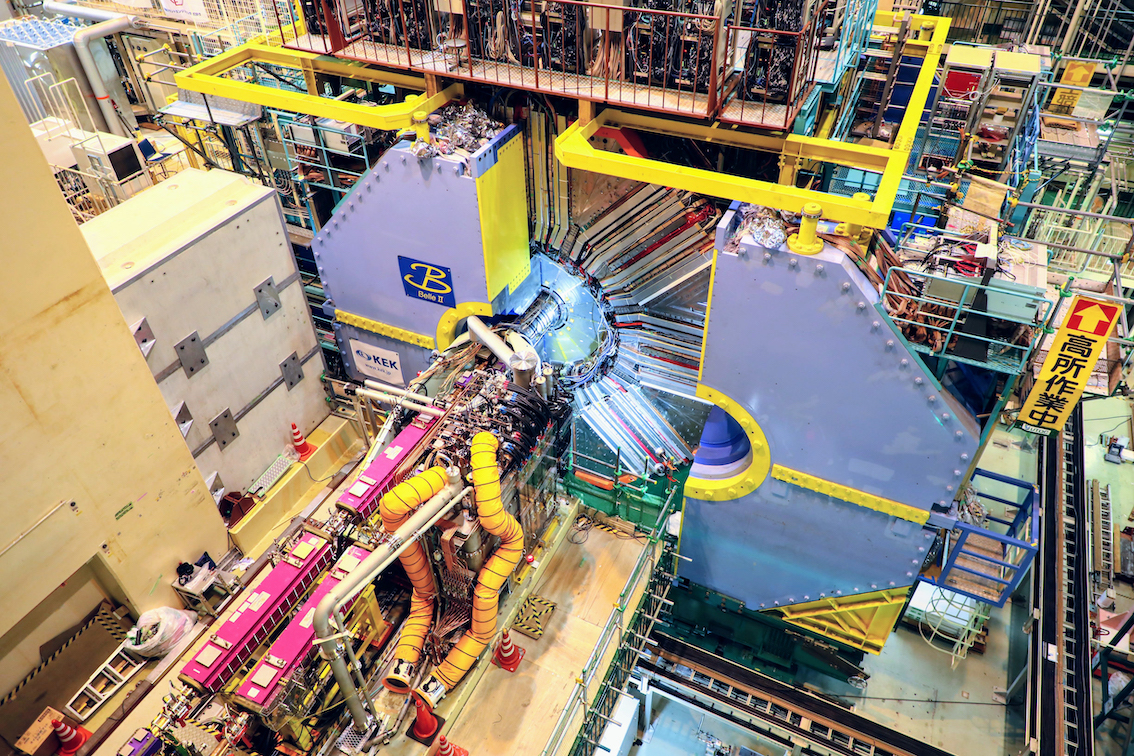
Experimental collider physics at KIT uses high energy particle collisions to test the Standard Model and to search for new phenomena, including dark matter. At CERN, research groups work on the CMS experiment at the Large Hadron Collider. At the SuperKEKB electron positron collider in Japan, KIT groups are involved in the Belle II experiment. KIT contributes not only to physics analyses, but also to the design, construction, commissioning, and operation of detector systems, as well as to key elements of software, computing, triggering, and data acquisition.
At the LHC, the focus lies on Higgs physics, electroweak processes, top-quark physics, and direct searches for physics beyond the Standard Model. At Belle II, precision measurements of rare decays and symmetry violating processes probe the same questions indirectly, through quantum effects at lower energies. In both cases, progress depends on detailed detector understanding, advanced reconstruction and analysis software, and statistically controlled analyses.
In addition, KIT is involved in the development of future experiments and facilities, including the SHiP beam dump experiment at CERN, strong field QED studies at the LUXE experiment at DESY, and design studies for next generation electron positron colliders such as FCC-ee. Here, machine-learning-based optimisation methods are pursued to jointly explore detector layouts, reconstruction strategies, and physics reach in an integrated way.
KSETA PIs working in this field are Jürgen Becker, Torben Ferber, Jan Kieseler, Markus Klute, Thomas Müller, Günter Quast, Klaus Rabbertz, Frank Simon and Roger Wolf.
Theoretical Collider Physics

Information about the forces acting between elementary particles is obtained by experiments, in which particles are scattered at very high energies. Highest energies and, hence, smallest distances are reached at modern colliders, such as the LHC at Geneva. Theoretical collider physics makes predictions for these experiments and helps interpreting the data.
This research field is closely connected to the field "Quantum Field Theory" described above, because precise calculations and simulations based on our current understanding of the interactions of elementary particles are needed to provide predictions within and beyond the Standard Model, to be tested at collider experiments. The simulations include Higgs physics, top-quark and jet physics, electroweak physics, flavour physics and predictions for dark matter searches at colliders.
KSETA PIs working in this field are Anke Biekötter, Monika Blanke, Stefan Gieseke, Gudrun Heinrich, Matthias Steinhauser, Kirill Melnikov and Felix Kahlhöfer.
Flavour Physics
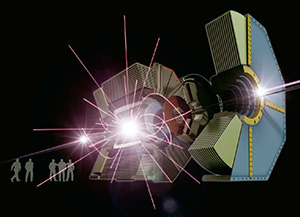
Flavour physics tests the Standard Model through precision studies of quark and lepton flavour changing processes. Many of the relevant observables are rare or loop induced, making them sensitive to new physics effects at energy scales far beyond those accessible in direct searches.
Experimentally, the main focus at KIT is on the Belle II experiment at SuperKEKB, where large and clean data samples enable high precision measurements of flavour observables and symmetry violations. KIT groups also analyse flavour related processes using data from the CMS experiment and are involved in the preparation of future measurements at the FCC-ee.
Theoretical work at KIT provides the calculations and frameworks needed to interpret these measurements. Since apparent deviations from Standard Model predictions are only meaningful if they can be explained consistently across multiple observables and experiments, within controlled theoretical and experimental uncertainties.
KSETA PIs working in this field are Monika Blanke (theory), Pablo Goldenzweig (experiment), Ulrich Nierste (theory), Robert Ziegler (thoery) and Frank Simon (experiment).
Neutrino Physics
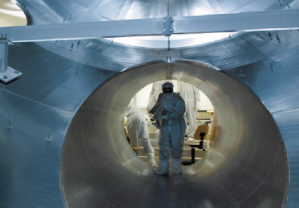
Neutrinos play a key role for our understanding of the Universe at the largest scales, as truly enormous numbers of neutrinos have been produced in the Big Bang. Their investigation touches and unifies fundamental questions of particle physics and cosmology.
To understand the role of these weakly interacting particles one has to measure the uncharted mass scale and mass hierarchy of neutrinos. The Karlsruhe Tritium Neutrino Experiment KATRIN is the first worldwide that measured directly and in a model-independent way the mass of neutrinos with a sufficient sensitivity to determine their role as cosmic architects. An update program has recently started to further push the limits of sensitivity. For KATRIN++ new technologies like an ultra sensitive quantum sensor array and an atomic tritium source need to be developed.
But also in particle physics the neutrino properties like the mass scale measured by KATRIN provide unique access to extensions of the Standard Model of particle physics.
KSETA PIs working in this field are Yanina Biondi (experiment), Sebastian Kempf (technology), Andreas Kopmann (technology), Oliver Sander (technology), Magnus Schlösser (technology), Thomas Schwetz-Mangold (theory), Kathrin Valerius (experiment) and Sascha Wüstling (technology).
Computational Physics (GridKa)

Particle and astroparticle physics critically depend on large-scale computing infrastructures that combine high-performance computing with globally distributed high-throughput systems, such as the Worldwide LHC Computing Grid (WLCG), to process and analyse the extreme data volumes produced by modern experiments.
At KIT, GridKa at the Scientific Centre for Computing (SCC) is one of the major Tier-1 centres of the WLCG and serves as a central hub for computing and data distribution for the LHC experiments as well as other particle and astroparticle physics communities. In addition to large-scale storage and compute capacity, GridKa provides reliable, continuously available services that support day-to-day experimental workflows.
At the same time, computing models are evolving rapidly. Modern reconstruction and data analysis increasingly rely on heterogeneous architectures, in particular accelerators such as GPUs, and on machine-learning-based algorithms with execution patterns that differ fundamentally from traditional workloads. KIT addresses this shift by developing inference-as-a-service approaches that decouple machine-learning inference from experiment software lifecycles, enabling efficient sharing, dynamic scaling, and flexible deployment of models across large numbers of jobs.
These developments are tightly linked to sustainability and resource efficiency. Dynamic scaling of services, adaptive use of heterogeneous hardware, and alignment of workloads with power-grid conditions are explored to reduce energy consumption while maintaining high throughput, treating computing not only as infrastructure but as an integral component of the physics programme.
KSETA PIs working in this field are Jan Kieseler and Achim Streit.
Technology Development

Already at the startup of the largest particle accelerator of the world, the LHC at CERN, Geneva, scientists of KCETA are working on the development of novel detectors for the next accelerator generation. It is aimed at increasing the resistance of the detector against radiation damage and at increasing the solid angle acceptance by using new cooling techniques.
For the KATRIN experiment unprecedented high vacuum systems and large superconducting magnet systems are designed and brought into operation. Locating the KATRIN experiment at KIT allows to make use of the unique expertise of the on-site Tritium Laboratory Karlsruhe (TLK), which is the only scientific laboratory equipped with a closed tritium cycle and licensed to handle the required amount of tritium.
The development of radio antennas for the detection of radio signals from air showers (LOPES) supports new promising options in the investigation of cosmic radiation. The method is optimized in prototype experiments.
We find refrigeration technology and cryotechnology in several of the research topics. They usually have the characteristic of an enabling technology in order to take advantage of special physical effects (e.g. supraconductivity)
KSETA PIs working in this field are Jürgen Becker, Beate Bornschein, Ralph Engel, Steffen Grohmann, Andreas Haungs, Bernhard Holzapfel, Tim Huege, Bianca Keilhauer, Matthias Kleifges, Andreas Kopmann, Ivan Perić, Markus Roth, Oliver Sander, Sascha Wüstling, Sebastian Kempf, Torben Ferber, Frank Hartmann, Markus Klute, Magnus Schlösser and Frank Simon.
Accelerator Research at KARA
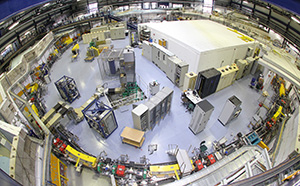
On the area of the Karlsruhe Institute of Technology, the Synchrotron Radiation Facility KARA is located in a hall of 5000 m2. There, electrons are accelerated in a storage ring to the energy of 2.5 GeV.
KARA is equipped with beamlines, which offer facilities for analytical research with synchrotron radiation in the spectral region between infrared/Terahertz and hard X-ray energies. Activities include hard X-ray lithographic microstructuring, spectroscopy, microscopy, diffraction, and imaging.
The KARA Accelerator Group is responsible for operation, maintainance and development of the KARA accelerator complex. This complex consists of the storage ring and its injector chain: e-gun, microtron and booster synchrotron. The Accelerator Development Program covers a variety of topics from the fields of single and multi-particle beam dynamics and optics. It includes design and study of new lattices for the storage ring as well as studies of new modes of operation like the dedicated low alpha mode for the production of short bunches.
KARA also offers a linac-based accelerator test facility called FLUTE.
KSETA PIs working in this field are Andreas Kopmann, Anke-Susanne Müller and Frank Simon.
Sensor Technologies and Detector Systems
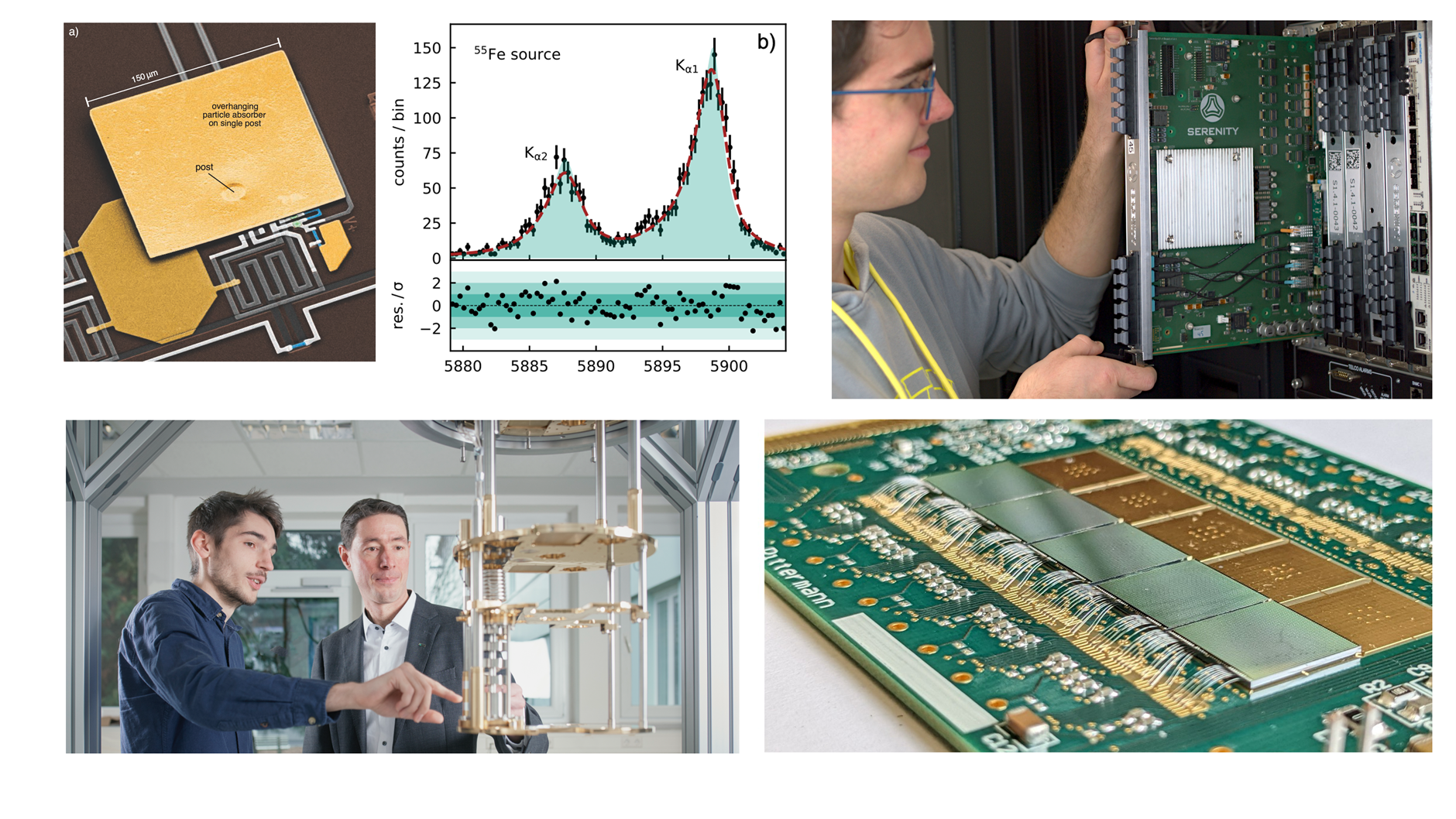
Advances and scientific progress in the field of elementary and astroparticle physics are very often driven by the development of new sensor technologies and detector systems. In this context, the continuous further development of existing detector systems as well as the development of completely new sensor technologies are indispensable and therefore lie at the core of the research activities of KSETA. Latest semiconductor technologies and advanced analog and programmable digital electronics are used to develop detector systems for future large-scale experiments. With these detectors, we aim to push space, time, and energy resolution limits. Efficient electronic readout systems are developed to manage ever-increasing data rates. Embedded intelligent trigger solutions enable coping with the data deluge of physics experiments. In KSETA an interdisciplinary team of engineers, computer scientists, and physicists is working in the field of detector systems development and covers a broad spectrum of technologies: sensor and readout electronics use application specific integrated circuits (ASICs), radiation-hard circuits, electronic packaging, silicon photonics for seamless integration of optical data transmission, massive parallel, distributed real-time data processing, signal processing, RF design technology, and finally commissioning, test and characterization for complex detector systems are required. In many areas of fundamental research, the resolution of "conventional" detector systems is not sufficient to tackle open questions with the necessary precision due to physical limitations. In these cases, superconductor-based quantum technologies are more frequently used. These type of sensors can often achieve resolutions that are orders of magnitude better compared to classical solutions. The activities in KSETA cover also for this type of sensors, operated close to the absolute temperature minimum, the full signal processing chain from the sensor, via readout by means of cryogenic multiplexing, to data processing and recording in real time.
KSETA PIs working in this field are Jürgen Becker, Sebastian Kempf, Andreas Kopmann, Ivan Perić, Oliver Sander, Sascha Wüstling, Torben Ferber and Frank Simon.
Software Defined DAQ
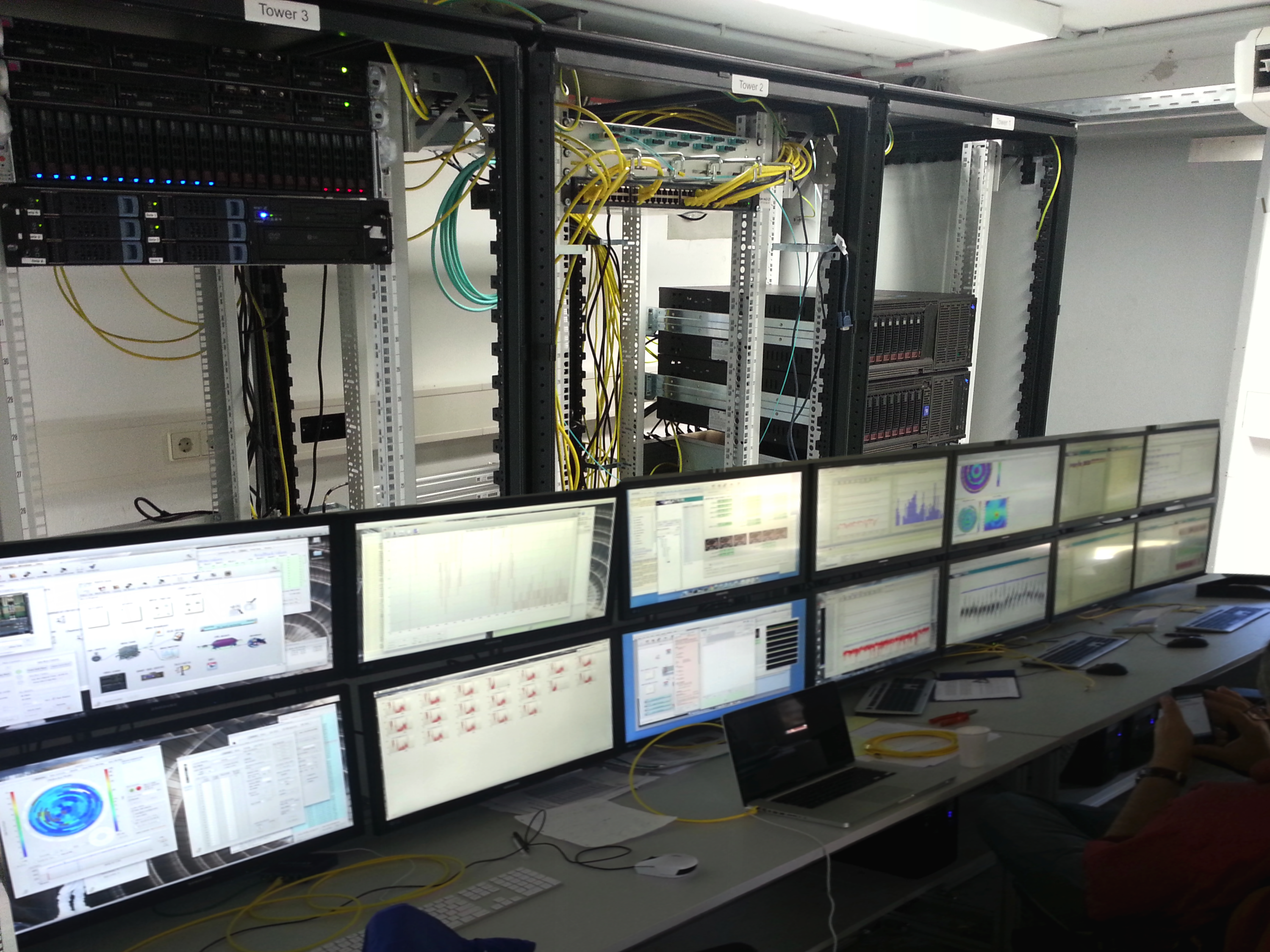
Novel instruments and detectors are key for future research in elementary particle physics and virtually all other scientific domains.
These devices pose large challenges with their rapidly increasing data rates which far outpace the improvements in the performance of storage systems. It makes online data processing and reduction ever more crucial for the next generation of detector systems. The Software Defined Data Acquisition paradigm relies on HPC and Cloud resources to build more sophisticated data processing chains than what is currently possible with traditional approaches. The key research areas include low-latency networking, scheduling, and data flow management; parallel, heterogeneous, and approximate computing; parallel and quantum algorithms; advanced databases, workflow engines, and orchestration systems.
KSETA PIs working in this field are Andreas Kopmann and Frank Simon.

